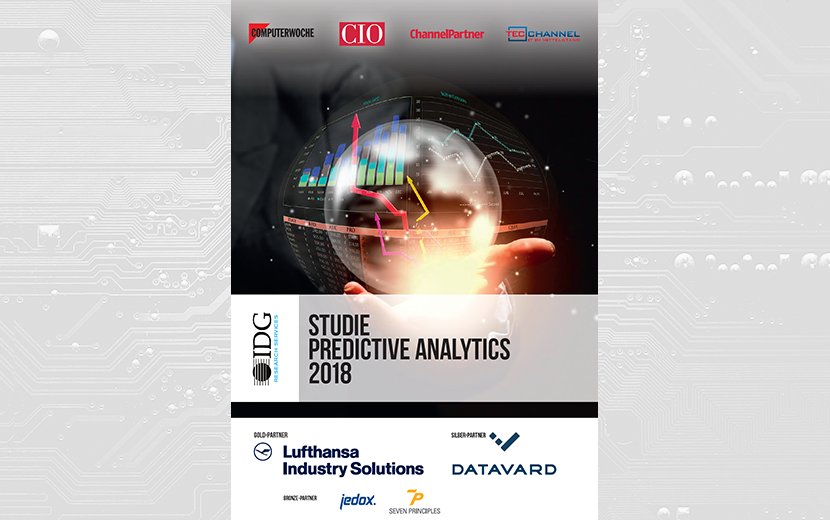Seeing into the future through comprehensive data analysis is possible – with predictive analytics. Data-based forecasts will become more and more relevant for companies over the coming years. The study shows that in spite of the barriers to entry, predictive analytics measures can pay off.
The IDG study “Predictive Analytics 2018”
Use predictive analytics today to find out what will be important tomorrow
Data can be worth money if it is used in a targeted manner and interpreted correctly. All areas of a company, from management to the individual departments, can benefit from predictive analysis, whether it’s used for pricing, sales forecasts, the proactive prevention of machine outages or general business orientation.
At the time of the study’s publication, around one-quarter of the companies surveyed generated significant revenues using this approach. In the future, this trend will become even more significant.
The complexity of the issue – as the companies also know – cannot be underestimated, however. Decision makers must nevertheless engage with the new ways of data analytics. Experts predict that anyone who does not work with data today is missing out on where the market is and will be left behind.
The study contains
- detailed figures on how decision makers and IT experts from almost 400 companies evaluate predictive analytics, a summary of the key findings and a look at the future,
- insights into the increasing relevance of predictive analytics and the range of objectives,
- answers to the questions of where the use of predictive data analytics makes sense and where there is still some catching up to do,
- an evaluation of companies’ satisfaction with the measures taken and projects implemented to date, and
- insights into potential investment areas for German companies.
Find out how high-ranking decision makers assess the current status and the role of predictive analytics for their companies (study only available in German).
Click here to download the summarized key findings of the study “Predictive Analytics 2018” (only available in German).
Die Studie wurde von IDG Research Services von März bis April 2018 durchgeführt. 390 Unternehmen aus verschiedenen Branchen und mit unterschiedlichen Unternehmensgrößen und Jahresumsätzen wurden befragt. Lufthansa Industry Solutions ist Partner der Studie und hat auch an den in der Studie aufgeführten Expertenrunden teilgenommen.
All key findings and additional study results can be found in their entirety in the study itself, which you can download for free (only available in German). Below are some of the study’s most important insights.
Predictive analytics will play an even greater role over the coming years
For 47 percent of companies, predictive analytics was highly or even very highly relevant at the time of the survey. Furthermore, around one-third expected that it would soon attain major or very major significance. Another third of those surveyed ranked predictive analytics as having a level of significance, with only 14 percent regarding it as not being important for the coming years. This figure varies greatly depending on the size of the company. For companies with more than 1,000 employees, predictive analytics is already of above-average significance.
Most companies are satisfied with existing predictive analytics measures
What kinds of prior experiences have companies had with predictive analytics? Almost 60 percent are satisfied or even very satisfied with the results. Smaller companies in particular seem to be convinced of the merits of predictive analytics measures, with a figure of 90 percent in this regard. Only 11 percent say they are dissatisfied and say that the benefits are not worth the effort and costs. Eighty-four percent of respondents say that a clearly defined business case that specifies a target is a prerequisite for the success of predictive analytics.
Investments in IT infrastructure and employee skills planned
Anyone who would like to seize the opportunities afforded by data analytics must often make investments in advance. That is why 40 percent of survey respondents say they will make investments within the next 12 months (at the time of the survey). A further 47 percent are not certain, but regard it as probable. The primarily concerns in this regard are improving IT infrastructure (46 percent) and boosting employees’ skills (40 percent) by creating new jobs or training existing personnel.
Companies are happy to accept external help from service partners
External service providers are in great demand. Only 17 percent work without a service provider, while 41 percent go so far as to put their trust in the expertise of several service providers. At 47 percent, the number of companies that do not utilize a service provider is higher at businesses with less than 100 employees. All companies surveyed are particularly inclined to rely on external providers for strategic advice (40 percent) and for technical advice (32 percent). The most important criterion in provider selection is trust, with sensitive data to be processed.
From management to research: areas of application for predictive analytics
Only 6 percent of the companies employing predictive analysis do not use the results in their decision-making processes. The vast majority make business decisions with the aid of data analysis. The measures are primarily used in IT, management and production. However, research, marketing and logistics also benefit from it.
To see all the results in detail, click here to download a free PDF of the “Predictive analytics 2018” study or the white paper (only available in German).





